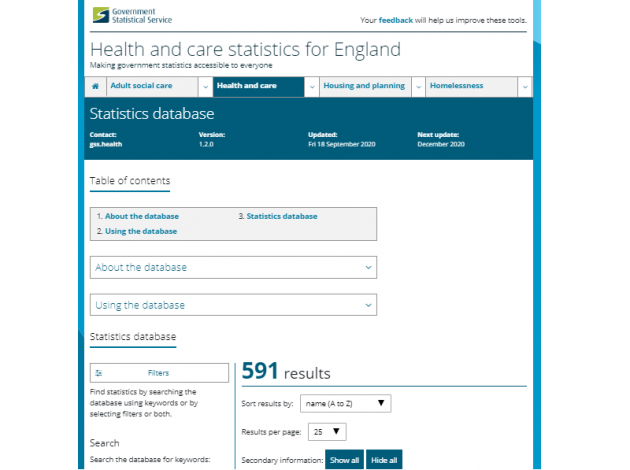Making health statistics more easily accessible

This week we’ve published a new tool which aims to bring together health statistics from across government in one place. Covering a wide range of topics from alcohol to dementia, the tool aims to make it easier for anyone to find the information they need on health in England. Theodore Joloza explains how this tool came about and why it is important.
Across the civil service analysts have a vital role to play in using data to provide evidence to inform policy making, implementation and assessment.
Of course, our work is not always easy. We work with the resources and tools available to us. With the advancement of technology, the tools we require have gotten more powerful as have the platforms for data dissemination allowing analysts to provide new insights into key issues of the day.
Health statistics in the UK come from a range of different sources which can make it harder for users to find and understand what is available.
This is why in 2018 we launched an early version of a health statistics tool for England. This week we are launching an improved version taking on board feedback we received.
This tool pulls together links to a wide range of published health statistics from across government in one place. It covers a range of themes from smoking to figures around births and dental care among others. This aims to make it easier for people trying to use our statistics by ensuring they don’t have to visit multiple websites to find the health statistics they need. With this tool, users can find the links to the statistics they require in one place by simply searching by theme, keyword or region.
So why now? Well, two reasons. The first reason takes us back to 2015 when feedback and results from consultations highlighted issues with the health statistical system. This prompted the UK Statistics Authority (UKSA) to step in. The Office for Statistics Regulation (OSR) a part of the UKSA opened a formal systemic review of the health and care statistics in England. The issues identified by OSR in the review included:
- Official health statisticians often focussed on servicing producers’ own immediate policy and operational uses.
- The health and care statistics landscape was data rich but information poor: the importance of analysis had been neglected, as had support for other analysts and researchers.
- Statistics were published on a variety of different websites, in different formats, with no single portal available to guide researchers or the public.
A lack of coordination was considered a large part of this problem. The main recommendation was for better collaboration to improve coherence and accessibility of health and social care in England.
In 2016, this resulted in the formation of the English Health Statistics Steering Group (EHSSG) which is chaired by the Office for National Statistics (ONS). Members include heads of health statistics from departments and agencies across England who have committed to pave the way for these improvements in their organisations and across the statistical system. Following initial progress, the OSR handed over the coordination role for improvement to EHSSG in May 2018. The improvements made so far include:
- More collaboration by statistical producers including establishment of EHSSG theme groups
- Removed duplication of statistical releases
- Published joint publications between departments
- Increased user engagement
- Established a beta landscape tool in 2018 enabling users to access published health statistics in one place.
The second reason for launching the health statistics landscape tool relates to the last bullet point above. Feedback we received told us that our early version was great at bringing all the information or related links into one place. However, while we had plenty of positive feedback, some people told us that they found the beta version intimidating.
After some iterations, we have now come up with a new tool for users which aims to be easier to navigate by a wider audience, from policy makers to academics to interested members of the public.
We realise that the requirements of people who use our statistics change, and technology is evolving all the time. We are working to keep up with both to ensure that we are making it easier for everyone to access and use these vital and important official statistics around health.
With this in mind, we are also working with teams across government to bring together a range of COVID-19 infection studies to help improve understanding of how they complement each other and how they contribute to our understanding of COVID-19. More detail on this work will follow in the coming weeks.

Theodore Joloza is Head of Health Statistics Transformation